Teachers and pupils can access the digital textbooks through the school's Opiq account, which is managed by an administrator in each school. When the user account is created, the pupil and teacher will automatically be granted access to the free digital textbooks, and when they log in to the platform, the free digital textbooks will be immediately available. You can find an overview of free digital textbooks in the Opiq Library via the "Free" package filter (link here).
In addition, schools have the possibility to purchase additional paid packages, for more information click here.
The "Õpilane 2022/23" package can be ordered by school administrators and pupils.
Additional information can be requested by writing to info@starcloud.ee or by calling +372 5323 7793 (Monday to Friday 9am-5pm). Follow also our Facebook page.
Create a user account
A teacher's Opiq account can be created via the school using the teacher's eKool or Stuudium account or via the teacher's email address.
If the school uses eKool
If the school uses eKool, the teacher's Opiq account must be created using eKool. The teacher links the eKool course to the Opiq digital textbook and Opiq accounts are automatically created for the teacher and the pupils on the teacher's course list. Read more here.
If the school uses Stuudium
If the school uses Stuudium, the teacher must create an Opiq account using Stuudium. The teacher links the Stuudium course to the Opiq digital textbook and Opiq accounts are automatically created for the teacher and the pupils on the teacher's course list. Read more here.
If the school does not have eKool or Stuudium
If your school does not have eKool or Stuudium, you will need to create a teacher Opiq account using your email address. To do this, the school administrator sends a subscription request to the teacher's email address, which becomes the Opiq login. Read more here.
The invitation contains a link which, when clicked, will take the teacher to a page where he or she can set a password. From then on, they can log in to Opiq by going to www.opiq.ee and entering their username and password.
NB: The invitation is valid for seven days. If, during this period, the teacher has not clicked on the link to set a password, the school administrator must resend the invitation. The invitation is valid once - once a password has been set, the same link cannot be used to set a password again. If the password is no longer remembered, to set a new password, you must go to the Opiq login page and click on 'Forgot password'.
Logging in
First it is important to makse sure if the school has an Opiq account and if the integration and pupils account is created on eKool, Stuudium or just by e-mail address.
Also review how to create a user account
Logging in if the school uses Opiq through eKool
To log in to an Opiq account created using eKool, you must use your eKool username and password.
Log in like this:
- Go to www.opiq.ee and click on the eKool logo. A window will open where you can click on the "Continue" button.
- When the eKool login page opens, enter your eKool username and password. Click on the "Login" button.
- The Opiq homepage opens and you can start using the digital materials right away.
Logging in if the school uses Opiq through Stuudium
To log in to an Opiq account made with Stuudium, you must use your Stuudium username and password.
Log in like this:
- Go to www.opiq.ee and click on the Stuudium logo. A window will appear where you can click on the "Continue" button.
- When the Stuudium view opens, find your school and then the Stuudium login page will open.
- Enter your Stuudium username and password. Click on the "Log in" button.
- The Opiq homepage opens and you can start using the digital materials right away.
Logging in if the school does not have eKool eKool or Stuudium
If the school does not have eKool or Stuudium, the Opiq account is created using an email address.
Log in like this:
- Go to www.opiq.ee and click on the Opiq logo.
- When the login window opens, enter your email address in the "username" field and your password in the "password" field.
- Click on the "Login" button.
- The Opiq homepage opens, and you can start using the digital materials right away.
Teacher’s front page
Logging in to Opiq opens the front-page view, which is divided into different blocks. Starting from the left, the blocks are: tasks, courses and Opiq shortcuts.
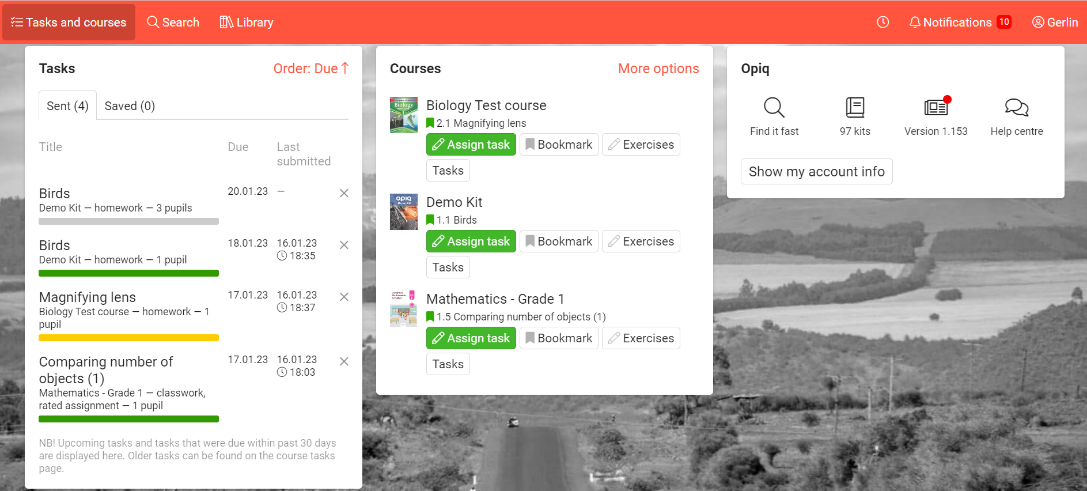
On the front page of a teacher with a Stuudium connection, there is a link to Stuudium in the top menu bar. On the front page of a teacher with an eKool connection, there is a link to eKool in the top menu bar.
The top menu bar of your teacher account has the following buttons:

- Tasks and courses: clicking on the logo opens the user's home page, regardless of which Opiq page the user is currently on.
- Search: Opens the search page.
- Library: overview of all digital textbooks in Opiq.
- Clock icon: opens the clock, timer and stopwatch. Clock, timer, stopwatch and timer. To stop and close the timer and the stopwatch, click on the "x" button.
- Notifications: Here you find notifications such as when pupil requests the return of assignment he has already submitted.
- Profile icon and name: settings, orders, licenses etc. Also you can find the opportunity to change roles or log out from Opiq.
Opiq direct references
The Opiq block on the front page provides the user with useful shortcuts.

In the Opiq block, there are shortcuts to the search, library and user guides’ page.
- "Find it fast" takes you to the chapter search page.
- Book icon. When new digital books are added, a red dot appears on the icon. Clicking on the icon will take you to the library, the most recently added digital textbooks will automatically be shown above in the list.
- A link with a version number that leads to the Opiq platform upgrade list page. A red dot will appear on the icon when the version number is updated.
- "Help Centre", which will take you to the user manuals page.
- "Show my account details" - Clicking on this button will show the user who they are logged in as and what connections they have.
Library and study kits
Teacher who is logged in to Opiq will have access to all the study kits in the Opiq library that are the part of the teacher licence package.
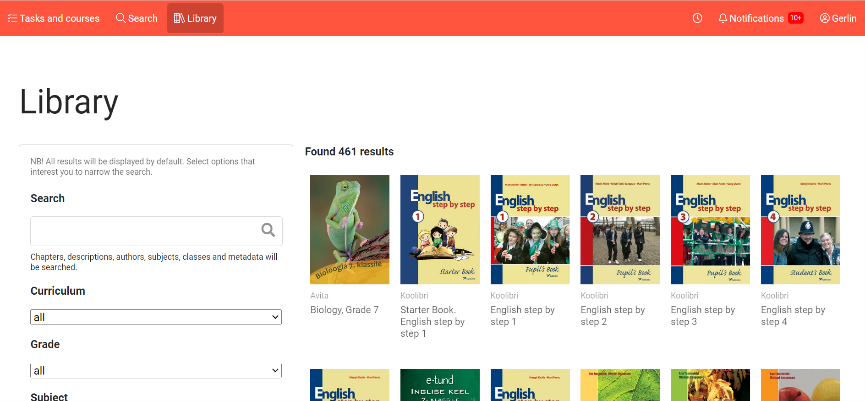
Study kit is a complete course for one subject/grade, corresponding to today's textbook and workbook set. It consists of chapters from the textbook and a set of tasks.
In the chapters of the textbook, the teacher can add her own material, which can also be seen by the pupils who belong to the course to which the textbook is linked. Clicking on the "More like this" link will display links to sections in the same or other units of study covering similar learning content. This makes it easy to find easier or more difficult material on the same topic. Clicking on a “add own content” it’s possible to share your own material there, pupils will see it in their digital textbook. There are links to the previous and next chapters in the top right-hand corner of the chapter.

A task excersises is a selection of tasks for each chapter that only the teacher can see. The pupil only sees these tasks when the teacher assigns them. The teacher can also add tasks to the set of tasks. Tasks that are partially or fully automated are marked with a lightning arrow.

Study kit
Each chapter of the study kit offers the following options.
Solving tasks in the chapter
Solve the exercises in the chapter, have them checked automatically or save the answers. The teacher does not see how the pupil has completed the exercises in the chapter section. The teacher can see the statistics of the learners performance in the chapter section.
Earch chapter in addition also has an exercise stack, but the pupil only sees exercises from it which the teacher has first assigned them.
Highlighting and commenting on the study kit text
The user can interact with the text by adding notes, comments and multi coloured highlights. To do this, select the text with your mouse or your finger on your smart device and select the highlight colour or comment option from the menu that opens. Save your comments and highlighted sections. When you reopen the chapter, the highlighting and comments will be retained.

Showing textbook text on an external display, e.g., a projector or smart board
The teacher can show the chapter texts, exercises, images, videos, animations on an external display, e.g., a projector or smart board. To do this, the images and videos included in the chapter and in the assessment bank can be opened in a new window, which can be dragged to another screen to show them to the pupils. To open a media file on the external display, click on the projector icon in the top corner of the image or video, or open the media file in the media gallery and click on the projector icon in the top left corner. To display multiple images contained in the chapter you can open the images as a media gallery, send it to the external display and then move between images in the media gallery. You will not need to repeat dragging for every image.

Adding files, links, or text to section
You can add files or text to each section. To do this, click on the "Add your own material" link. The material added by the teacher will be visible to the pupils in specific course.

Searching content that is related to a section
There is a "More like this" link for each section. Clicking on this link will search for material related to the content of that section from earlier and later materials in the same subject, as well as from other subjects. This allows the teacher to find exercises and materials of varying difficulty on the same topic to incorporate to meet the needs of different learners abilities.
Copying a section link or reporting a mistake
At the end of each section, there is a link "More options" which offers two options:

- “Copy link” - the link to section will be available to paste as quick and direct reference to other teachers or to pupils.
- “Report Mistake” - by reporting a mistake you can point out if you find any mistakes in the text. This way the editors of the text can take fix the error.

Course
You can create a course of the study kits found in Library. The course brings together the study materials, the pupils and the teachers.

The study kit included in the course allows to:
- add pupils and teachers as users of the course;
- teacher to assign tasks and exercises to pupils and assess those;
- teachers and pupils to find the teaching material used in their lessons on the home page of Opiq - textbook chapters, teacher-assigned work and teacher feedback (including grades);
- add your own material (including assignments) to the learning kit to share with pupils;
- use a learning sequence that allows the teacher and the pupils to quickly find the right chapter and content from the Opiq home page.
Several study kits can be linked to a course!
Study kits where a pupil has been added to can be seen on pupils dashboard in bookmarks block. The bookmarks display shortcuts to the chapters that the teacher has set as the study sequence in the courses.
Adding courses to an eKool school connection
Once the school administrator has linked the school in Opiq to the corresponding school in eKool, teachers will be able to transfer courses from eKool to Opiq. The name of the course and the names of the pupils and teachers are transferred to Opiq. If the pupils have not used Opiq before, they will create an Opiq account during the course import. To log in to Opiq, they can click on the eKool link on the login page and identify themselves via eKool.
NB! If a teacher or pupil already has an Opiq account, they will need to link their Opiq account to eKool before importing the course from eKool. This can be done by each user on their settings page by selecting "Connections" and clicking on the "Add connection" button in the eKool block on the page that opens.
If a pupil has an Opiq account but has not linked it to eKool, and the teacher imports a course from eKool to Opiq to which the pupil also belongs, a new, different account will be created for that pupil, because no link is created in the system between the existing Opiq account and the new account created by the course transfer. If this situation arises, it is worth contacting the school administrator.
Importing the course to Opiq (eKool)
- The teacher logs in to eKool.
- The teacher opens the course for which he/she wants to enter data (pupils) in Opiq.
- On the page that opens, there is a line at the very bottom "Näita töökava / materjale" and a button "Lisa materjale" on the right-hand side. This is the button to click.

- In the "Lisa päevikule materjale" window that opens, select the "Seo õpikeskkonnaga" tab and click on the "Saada" button.

- A window will appear where you have to select the learning set in Opiq to which you want to link the transferable course. If all the information is correct, click on the “Seo päevik Opiquga" button.
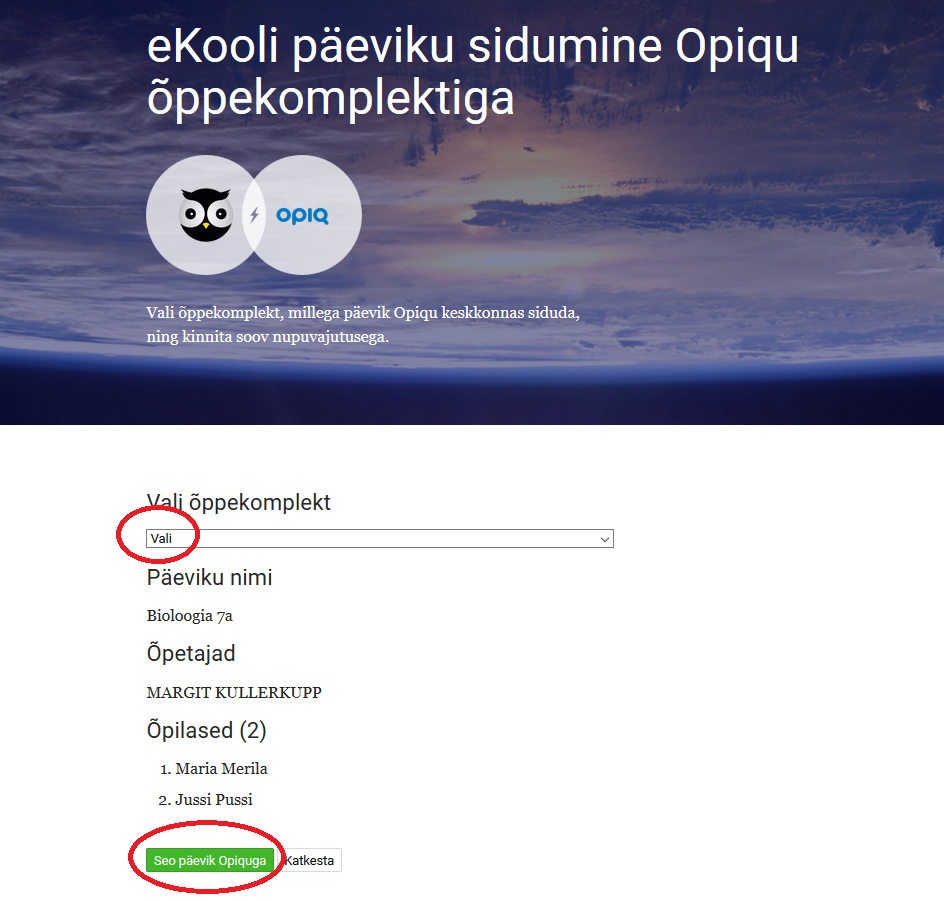
- During the course linking process, in addition to the course data, teacher and pupil user accounts will be created in Opiqs, if necessary. If a user has an Opiqs user from a previous time and it is connected to eKool, the course will be linked to the user from that previous time, but no new user will be created.
- Once the course has been successfully linked, you will see a notification page where you can click on the "Logi Opiqusse sisse eKooli kontoga" button.

- The teacher logs into Opiq and can use the course from eKool just like the course created in Opiq: set bookmarks, assign work to pupils, correct it, etc.
Once the course has been imported from the eKool to Opiq, an Opiq logo button will appear next to the "Add materials" button on the eKool course page.

Updating the course (eKool)
If you want to change the name of the course, the pupils or the teachers, you have to do it in eKool. Once a day, changed courses are automatically updated in Opiq, but if you want to change the data immediately, you must click on the button with the Opiq logo on the corresponding course page in eKool.

On the page that opens, you can review the course details and then click on the "Uuenda päeviku andmeid" button.
You can add and remove study sets linked to a course in the course settings page in Opiq.

Deleting the course (eKool)
You can delete a course in the course settings page in Opiqs. Deleting a course in Opiqs does not in any way affect the same course in eKool.
Adding a course in Opiq
If the school is connected to eKool but the teacher does not wish to transfer courses or users from eKool for whatever reason, he/she can also add a course in Opiq, following the instructions below.
Adding a course in a school with a Stuudium connection
In order for a teacher to be able to import a course from Stuudium to Opiq, the school administrator must have added a link between Opiq and Stuudium on the school settings page. Once this has been done, a teacher using the Stuudium can import his/her course from Stuudium to Opiq. The name of the course, the pupils and the teacher are imported from Stuudium to Opiq. Once the course has been imported, both the teacher and the pupil will be able to log in to Opiq with their Stuudium data and the imported course will immediately appear on the teacher's home page in Opiq. In addition, homework type assignments will also be uploaded to Stuudium.
NB! If the school administrator has linked the school account to Stuudium, pupils and teachers with an existing Opiq account must link their Opiq account to Stuudium before importing the course from Stuudium. This can be done by each user on their settings page by selecting "Liidestused" and clicking on the "Lisa liidestus" button in the Stuudium block on the page that opens.
If a pupil has an Opiq account, but has not linked it to Stuudium, and the teacher imports a course from Stuudium to Opiq to which the pupil also belongs, a new, different account will be created for that pupil, because no link is created in the system between the existing Opiq account and the new account created by the course import. If this situation arises, it is worth contacting the school administrator.
Importing the course to Opiq (Stuudium)
- The teacher opens the transferable course page in Stuudium and clicks on the "Lisa õppematerjalid" button. In the menu that appears, select "Opiq e-õpik".
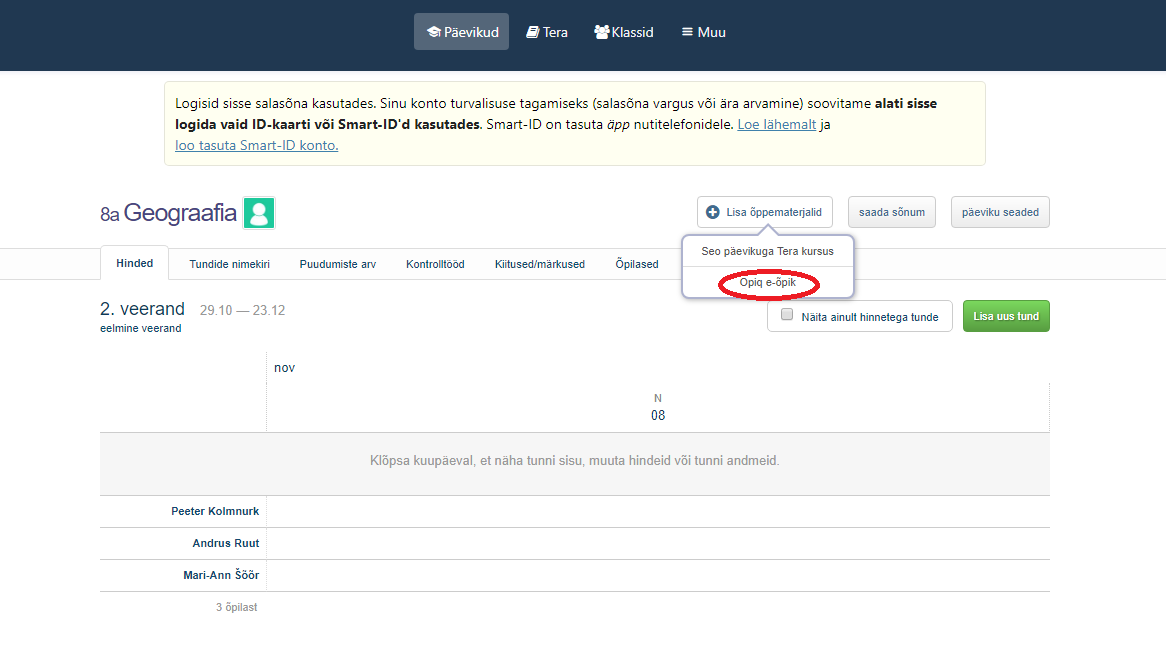
- If the teacher is already logged in to Opiq, a page will open asking for consent to log out of Opiq. This must be accepted.
- A page opens where you have to choose which study set in the Opiq library to link the Stuudium course to. The names of the course, the teacher(s) and the pupils are also displayed. If everything is correct, click on the "Seo päevik Opiquga" button.
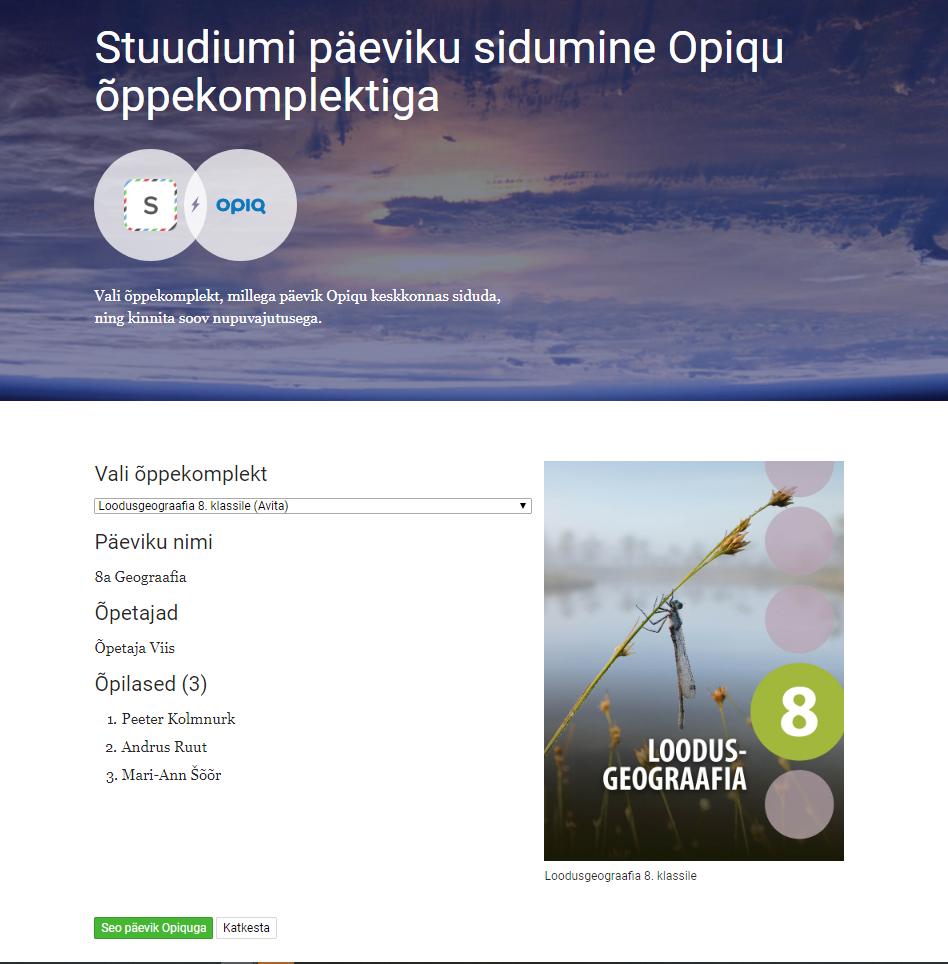
- After a successful course import, the teacher will be redirected to the course settings page in Opiq.

Now, both teacher and pupil can log in to Opiq with their Stuudium data. To enter Opiq, pupils and teachers need to select the Stuudiumi logo on www.opiq.ee, identify themselves with their Stuudiumi username and password and then they will be logged into Opiq.
Updating the course (Stuudium)
On the course settings page, you can add and remove study kits associated with the course and delete the course. However, the course name, teacher and pupils can be changed in Stuudium. If these details have been changed in Stuudium, they will soon be updated in Opiq.
Deleting the course (Stuudium)
You can delete a course from the course settings page in Opiq. Deleting a course in Opiq does not in any way affect the same course in Stuudium.
Adding a course in Opiq
If the school is connected to Stuudium but the teacher does not wish to transfer courses or users from Stuudium for whatever reason, he/she can also add a course in Opiq, following the instructions below.
Adding a course in schools that do not use eKool or Stuudium
Courses can be created by the school administrator or teacher. If the school does not use eKool or Stuudium, there are two ways for the teacher to add a course:
- Option A. Select a study kit/textbook from the library and click on the "Add as course" button.
- Option B. On the “Courses” view, click on "Add a course";
Adding a course in Opiq
Option A
- Click on "Library" in the top menu bar;
- Select the study kit you want, click on the picture of the digital textbook;
- A view of the contents of the digital course opens, click on the green "Add as course" button;

- A window will open, name the course, and click on the "Add study kit as a course" button.

You can find the course you created on your front page and on courses page, where you can add teachers and pupils to your course. See here, on how to add pupils to the course.
Option B
- Click on “More options” under the courses on the front page of the teacher’s view;
- The “Courses” view opens, click on "Add a course";
- Click on "Add Opiq course".

- The course adding page opens, where you can enter a name for the course.
- Select the study kit to which the course is linked from the drop-down menu and click on the name of the digital course.

- Check that your name is automatically displayed as a teacher. You can add other teachers to a course. If the teacher you want to add does not already have an Opiq account, they will receive an email invitation to join Opiq. If an account already exists, no invitation will be sent.

- The corresponding logo and user name will be displayed to the user associated with eKool or Stuudium.


- Click the "Save" button.

- Next, Opiq creates a course and opens the course page.

In the block "Study kit" you can see the study packs related to the course. If you wish to use other study kits in the work of this course, you must add them by clicking on the "Settings" and then “Add kit” buttons. In the block “Tasks” you can see statistics and the progress of the tasks you have assigned to pupils.
Adding pupils to the course
To add pupils to the created course, click on the "Add or edit pupils" button in the course settings view. A large number of pupils can be conveniently added at once via the "Import pupils" button.

Clicking on "Add or edit pupils" will open the Add pupils view.

On the "Import pupils" page, you can enter pupils one by one or select them from existing or archived courses or classes. Pupils who do not yet have an Opiq account will receive an email invitation to join Opiq. If the pupil already has an Opiq account, the invitation is not sent and the course will be visible among his/her other courses.
Adding a pupil role to a teacher account
Teachers can create a course in Opiq where they are both teacher and pupil at the same time. When a teacher adds him/herself as a pupil in the course, the teacher automatically becomes a pupil. This allows the teacher to log into Opiq as a pupil and experiment with, for example, sending himself/herself homework. NOTE: This course is not linked to eKool or Stuudium and the teacher will only see the course in Opiq.
- Start adding a course.
- Once the course is created, to add yourself as a pupil in the course, click on the "Add or edit pupils" button in the course settings.
- The Add pupils view opens. Enter your details in the list of pupils and click "Add users".

- After adding a teacher as a pupil in the course, you will automatically be assigned the role of pupil in Opiq. In the course settings, you will see the teacher's name as both teacher and pupil.

Switching to pupil role
To use Opiq as a pupil, do the following:
- Click on your name in the top menu bar.
- Click on the link "Change role"
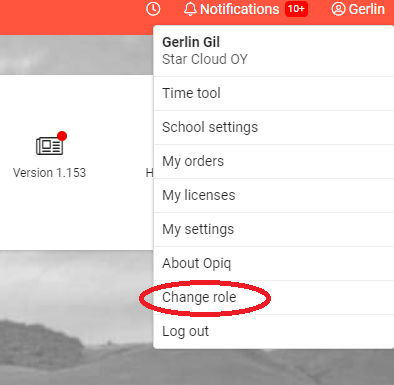
- A window will open showing which roles are associated with your user account. Click on the "Pupil" link.

- You will be presented with the Opiq platform in pupil view.
Teachers' Book (e-tund)
A teacher's book is a set of lessons that can only be viewed by users with the role of teacher and school administrator. A teacher's book can be added to a course and from which a set of tasks can be assigned to pupils. The chapters in the textbook are not visible to pupils.
The first teacher's book on Opiq is "Matemaatika 6. klassile, e-tund" (see the material from Opiq here).
In order for the teacher and pupils to have access to the e-learning digital kit, the school must place an order (for more information click here).
Task assignment
Opiq study kits consist of chapters and stack of exercises. The pupils do not see the exercises from a stack, they only see exercises in the study text (chapter) and the assignments that the teacher has assigned to them from an exercise stack.


Assigning task
To assign a task, click on the green "Assign task" button.

The "Assign task” button can be found in several different places:
- on the front page of the teacher's courses;

- the list of contents in the course;
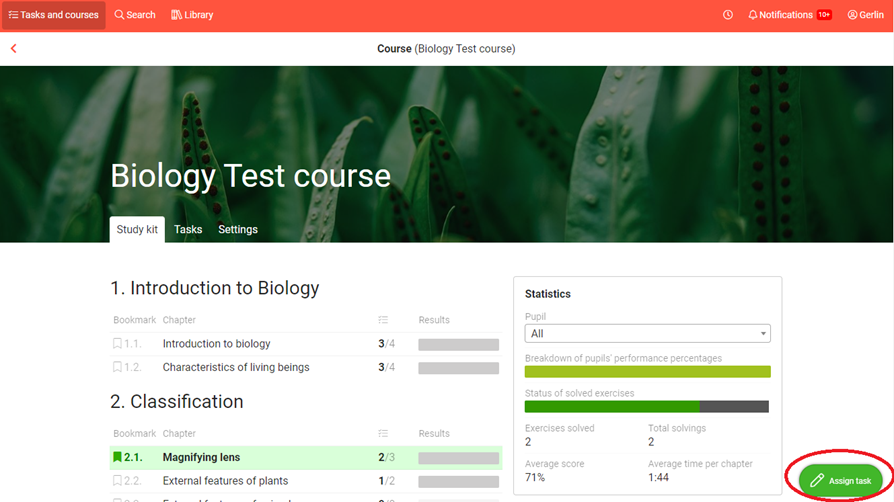
- set of tasks per chapter of the study package.

Clicking on the "Assign task" button opens a window where you can choose which tasks to assign to whom and by when.

Choose exercises
In this block, you can choose which tasks to assign to pupils.
You can choose exercises from all study kits. When a teacher starts assigning a task from a course, the list of exercises will start with the course study kit and then all the other teaching sets belonging to the packages for which the teacher has a license.
The work assigned by the teacher can contain up to 50 tasks. A lightning arrow after the task title indicates an auto-check task, hovering the mouse over the information icon shows a description of the task and clicking on the magnifier icon opens the task in a new window.
To select a task, tick the box in front of it. You can see all the selected tasks by clicking on the "Selected exercises" tab.
Set task properties
In this block you can specify the type of work, description and deadline.
If the work is assigned to course pupils from Stuudium, the homework will also be sent to Stuudium.
Select task assignees
In this block you can choose which pupils to assign the assignment to. The teacher can edit the course and choose how many pupils the assignment will be sent to. The assignment will be sent to the pupils whose name is ticked in the box in front of the assignment.

Once the teacher has clicked on the green "Send" button, the work is sent to the pupils.

In addition, you can save your work by clicking on the "Save" button. Saved work can be seen on the teacher's homepage in the left-hand block next to the submitted work.
Once the work has been sent by the teacher, you will see the work on your homepage in the shared work block and on the work page of your course.


The pupil sees the tasks assigned to him/her:
- on your front page in the tasks section;
- in your learning materials on the course works page;
- in case of an eKool connection in your eKool;
- In case of a Stuudium connection in your Stuudium;
Read the pupil's user guide to find out how to solve the assigned task (link here).
Giving feedback on submitted tasks
The teacher can see on his/her front page, in the sent tasks block and on the tasks page of the course, the tasks assigned and, on the scale after it, the distribution of the tasks: how much work has been submitted, how much has been evaluated and with what grades.
Clicking on the title of the task opens the task overview page, where you can see all the pupils who have received the task, information on whether the assignment has been submitted to the teacher, and statistics on the tasks.
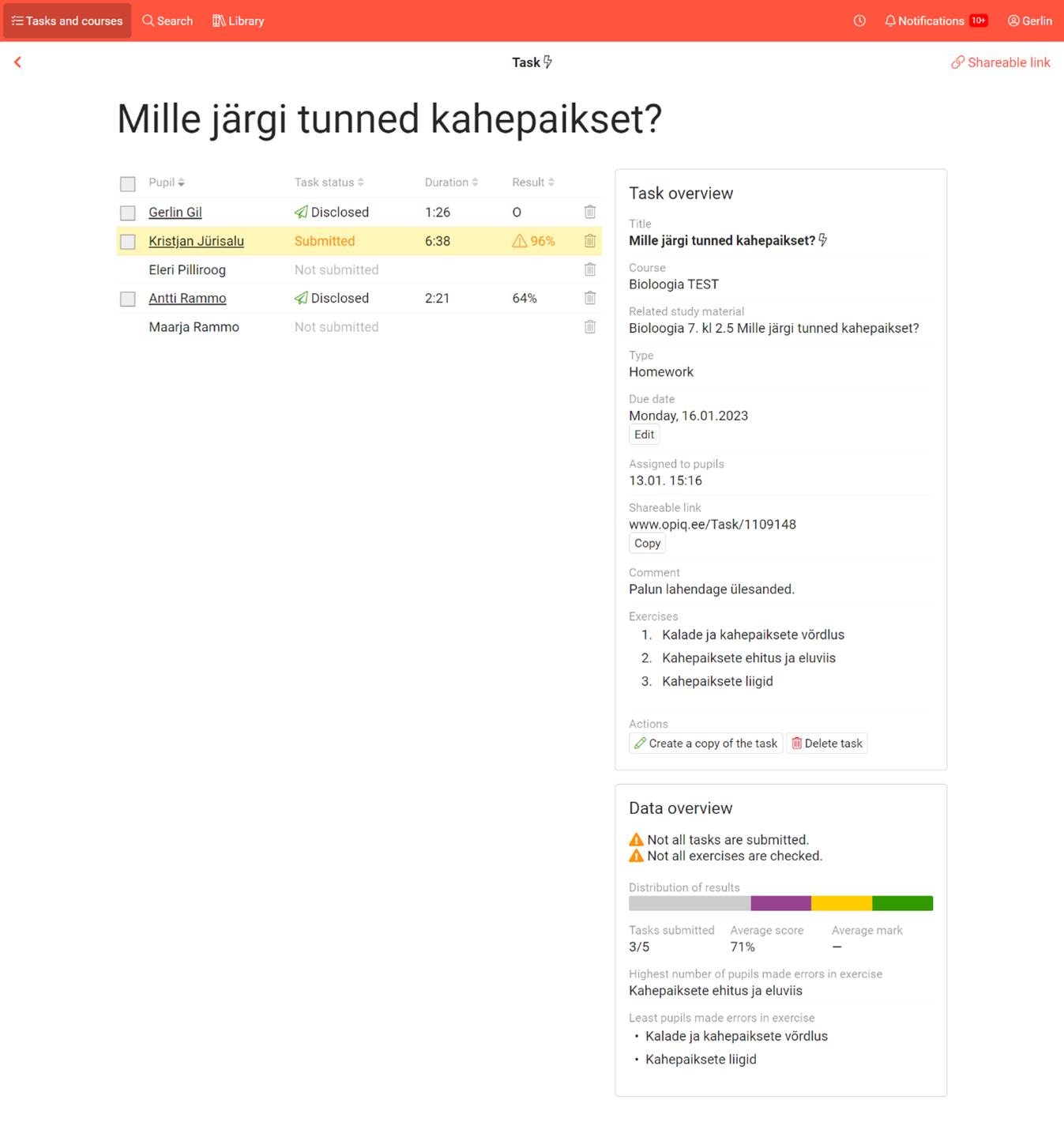
If the assignment is made up of automatic tasks, the teacher does not necessarily need to review the pupils' work. Opiq calculates the percentage of the pupil's work that is correct and displays it in the “Result” column.
If there are tasks in the work that cannot be automatically checked, a safety triangle will be displayed with a message to that effect.
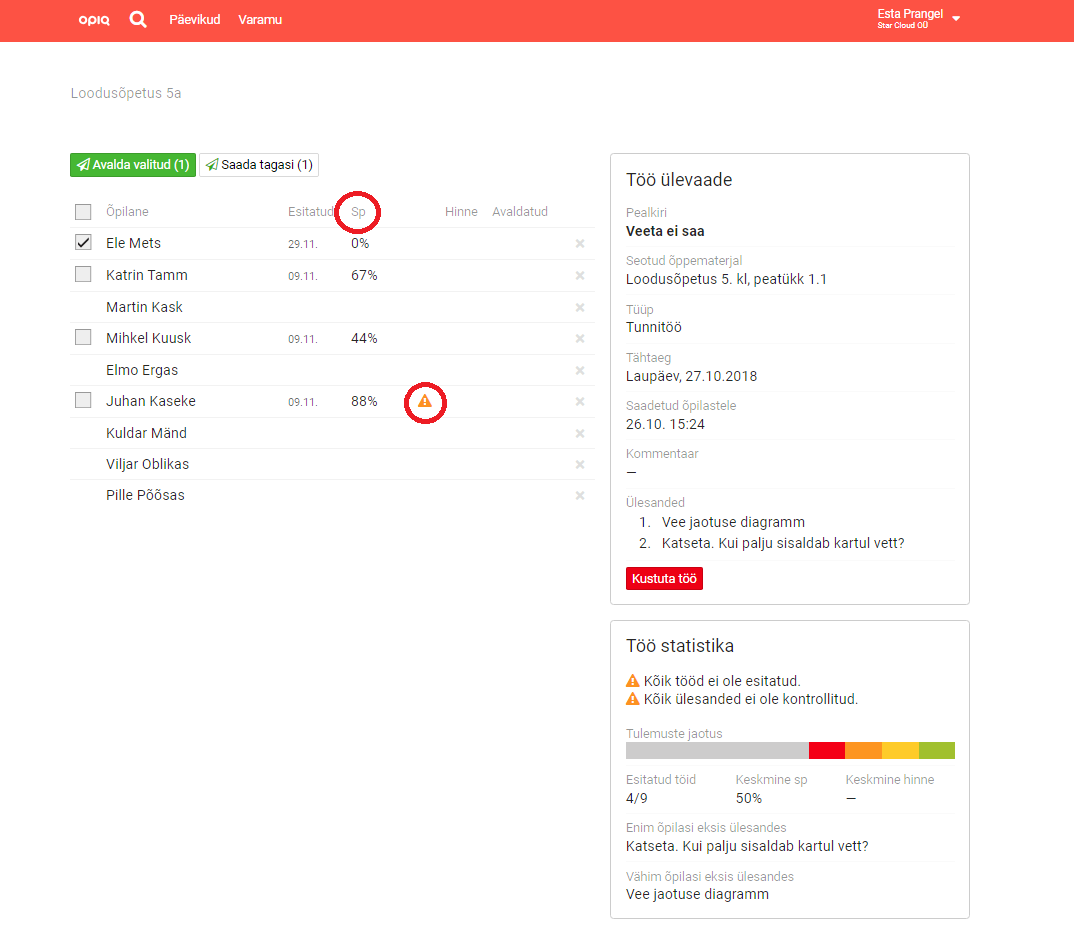
In the case of auto-check tasks, the teacher can simply tick the boxes in front of the pupils' names and press the "Disclose selected" button.
There is a "Send back" button next to the "Disclose selected" button. When clicked, the selected work is sent back to the pupils. The pupil's answers and the teacher's own comments will remain in the work, while the attached files and the marks given to the work will be deleted. The returned work can be edited and resubmitted by the pupil. If the pupil resubmits the work, the teacher should decide, when checking and marking the work, whether the comments he or she has previously added are still relevant or whether they should now be deleted before the result is published.
Clicking on the pupil's name opens the assessment view. The teacher can see on the review page of the pupil's work how the pupil has rated his/her work in the five-star system.
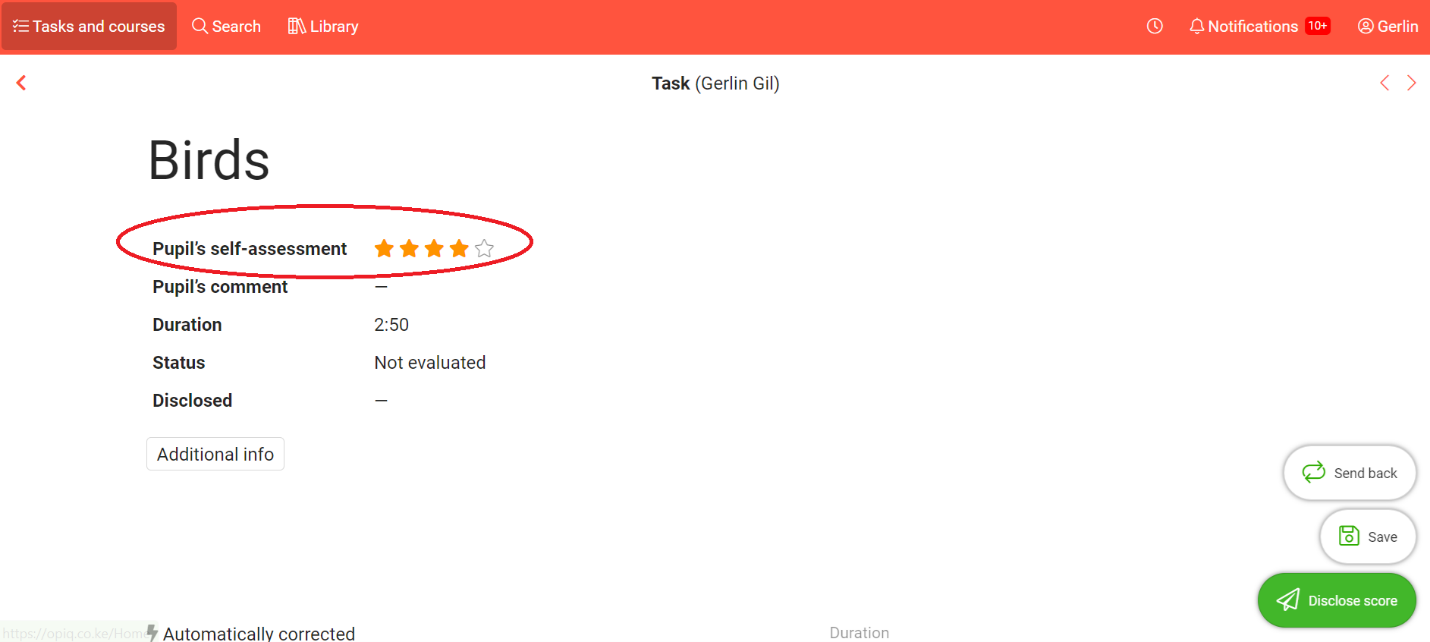
The teacher can see which answers are right and which are wrong in the automatic check tasks. If necessary, the teacher can change this by clicking on the pupil's answer. If the task is not auto checkable, the teacher has to decide which answers are correct, which are incorrect and which are not checked.

✓ – correct answer; x – wrong answer; ! – unverified answer; ? – answer not evaluated
While doing the tasks, the pupil can indicate the level of difficulty he/she thinks the task is. There are three options to choose from - easy, average, difficult (example on the screen shot). The teacher can see the level of difficulty selected by the pupil in the task view.

At the end of the page there is an overview of the work and a feedback block.
Types of feedback

- Mark 1-5 – allows you to enter a score on a scale of 1–5 and add +/- to it.
- Score of correct answers – shows the percentage of correct answers out of the total number of correct and incorrect answers. Calculated automatically.
- Formative assessment – the teacher writes a comment on the work in a summary comment box.
- Other grade – option to enter another grade, e.g. A, B, C.
The teacher can then click on "Disclose mark " to send the assignment with the result to the pupil immediately, or click on "Save" to save the feedback given but not send the assignment to the pupil at this time. The work can also be published afterwards on the work review page. Once the work has been published, the teacher can still edit the feedback afterwards and republish it if desired.
Once the teacher has published the result of the pupil's assignment, an notification appears on the pupil's Opiq front page and the feedback can be found in "Rated" block. The pupil can click on the title of the work to open it and see the results.
Search
The quickest and most efficient way to find learning content is to use the search. You can access the search page by clicking on the top menu bar. The teacher can search from the textbook chapters of all the Opiq library study sets.
Chapter search
The content of all chapters of all textbooks in the Opiq library, including the tasks in the chapter, are searched. Search results are displayed with section precision. After all search results have been found, the results can be narrowed down using the grade and subject filters.
Tasks search
Searched from all sets of tasks in all sets and from tasks created by the teacher. After all search results have been found, the results can be narrowed down using class and subject filters and according to whether the task is automatically checked or not.
Library search
Search the tables of contents and descriptions of all the study kits in the Opiq library. If no search term is entered, all the works in the library are displayed. Results can be filtered by grade, subject, publisher, package and language of the material.
Settings
The teacher can click on their name in the top right-hand bar to open a settings menu with different options.
The options available under the "My settings" link are:
- Change password
- Change username
- Choose your language
- Browser Automatic Translation
- Connections with external user accounts
- Private user role
- My orders
- My licenses
Connections with external user accounts and interfaces
To make it easier to log in, users can link their Opiq account to their Google, Facebook, mobile ID, ID card, HarID, eKool or Stuudium account. The teacher can click on the "Connections with external user accounts" link on their settings page and then add an connection to the external environment. Once this is done, it will no longer be necessary to enter your user ID and password to log in to Opiq, it will be sufficient to click on the logo of the external environment in the login window.
For example, if a user has added a connection with Google and is currently logged in to Google, clicking on the Google logo on the Opiq login page is enough to immediately log him/her into Opiq.
NB! eKool and Stuudium interfaces
If a teacher wishes to import courses from eKool or Stuudium, they should bear the following in mind.
If a teacher or pupil already has an Opiq account, they will need to link their Opiq account to eKool or Stuudium before import the course from eKool or Stuudium respectively. This can be done by each user on their settings page by selecting "Connections with external user accounts" and clicking on the "Add connection" button in the eKool or Stuudium block on the page that opens.
If a pupil has an Opiq account, but has not linked it to eKool or Stuudium, and the teacher imports a course from eKool or Stuudium to Opiq, to which the pupil also belongs, a new, different account will be created for that pupil, because no link is created in the system between the existing Opiq account, and the new account created by the course import. If this situation arises, it is worth contacting the school administrator.
Licenses
To use Opiq for educational purposes, the user must have a license. The license gives the pupil access to all the textbooks in the Opiq Library that are part of a specific package.
When you create an Opiq account, free licenses are automatically added for pupils and teachers. In addition, schools can purchase additional paid packages, for more information click here.
Pupil licenses
Paid licenses can be ordered by the pupil and the school administrator. Find out more about how a pupil can order a license.
Find out how your school administrator can order a license.
The pupil license gives access to all published materials in the Opiq Library that are included in the pupil license package. The pupil will not be able to access a set of assignments that is only available to a user with the role of teacher.
The teacher can see information about the existence and validity of pupils' licenses in the settings page of the course. The icon displayed shows the license information for the selected learning package in the course.

If a pupil is included in the course who does not have a valid license, a warning will be displayed to the teacher on the teacher's home page as well as on the course's content and settings page. The school administrator will also be informed on his/her home page.

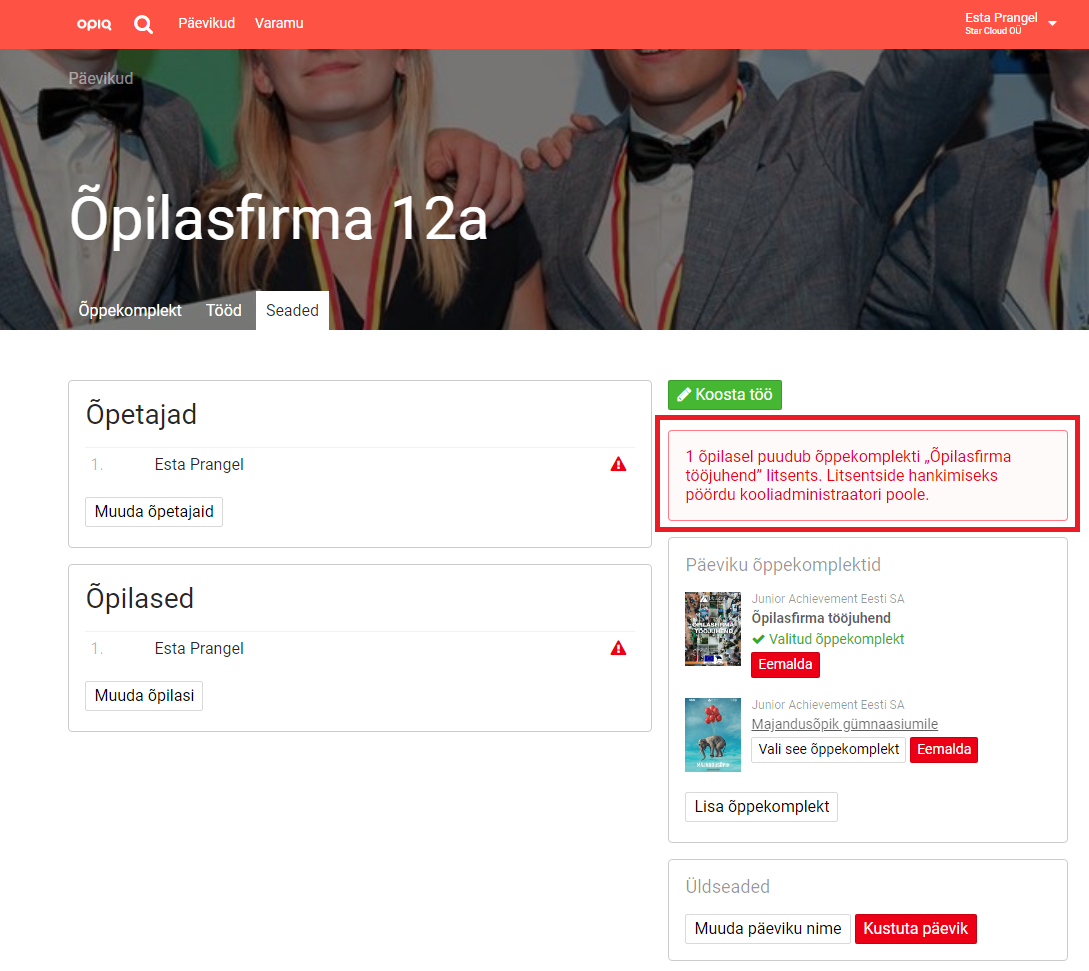
Õpetaja litsentsid
Teachers can use Opiq for their lessons if the school has ordered a teacher license and added it to the teacher's Opiq account. A teacher can see his/her license information if he/she has added himself/herself as a teacher in a course and opens the settings page of that course. In the teachers block, there is an icon after the name which displays the license information for the selected teaching package in the course, and information about the licenses for all packages can be seen by moving the mouse over the icon.

Additional information
For additional information contact info@starcloud.ee or call the phone number +372 5323 7793 (Monday to Friday 9am-5pm). Follow also our Facebook page.


